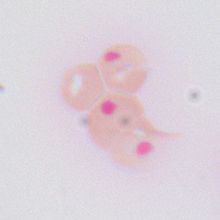Heinz body
Heinz bodies (also referred to as "Heinz-Ehrlich bodies") are
History
They are named after Robert Heinz (1865–1924), a German physician who in 1890 described these inclusions in connection with cases of hemolytic anemia.[3][4]
Form and appearance

Heinz bodies appear as small round inclusions within the red cell body, though they are not visible when stained with Romanowsky dyes. They are visualized more clearly with supravital staining[5][6] (e.g., with new methylene blue, crystal violet or bromocresol green).
Causes
Heinz bodies are formed by damage to the
There are several pathways leading to the hemoglobin damage.
- NADPH deficiency can cause a dysfunction in glutathione peroxidase which is an enzyme that converts hydrogen peroxide (a reactive oxygen species) into water.
- G6PD (glucose-6-phosphate dehydrogenase) deficiency exacerbated by administration of oxidant drugs (e.g., primaquine, dapsone, quinidine) can also result in Heinz bodies. G6PD deficient red cells in combination with high levels of oxidants causes a cross-linking of sulfhydryl groups on globin chains which causes a denaturing and formation of Heinz body precipitates.[8]
- Heinz bodies can also be found in chronic liver disease.[9]
- quaternary structureof hemoglobin.
The presence of Heinz bodies may also be a feature of hyposplenism or asplenia, when a damaged or absent spleen cannot remove these damaged cells from circulation.
Veterinary
Heinz bodies are associated with the consumption of paracetamol (acetaminophen), garlic,[11][12] and onions by cats,[13] dogs, and various primates. Thiosulfate compounds in the flesh of onions have been identified as the cause.
Propylene glycol was once a common ingredient in soft moist cat food. According to the FDA "It was known for some time that propylene glycol caused Heinz Body formation in the red blood cells of cats (small clumps of proteins seen in the cells when viewed under the microscope), but it could not be shown to cause overt anemia or other clinical effects. However, recent reports in the veterinary literature of scientifically sound studies have shown that propylene glycol reduces the red blood cell survival time, renders red blood cells more susceptible to oxidative damage, and has other adverse effects in cats consuming the substance at levels found in soft-moist food.[14] In light of this new data, CVM amended the regulations to expressly prohibit the use of propylene glycol in cat foods."[15]
Treatment
There is no specific treatment for Heinz bodies; however, they are important as a diagnostic indicator for the causative conditions listed above.
References
- ^ Heinz+Bodies at the U.S. National Library of Medicine Medical Subject Headings (MeSH)
- ^ "Unstable Hemoglobins: The Role of Heme Loss in Heinz Body Formation" Jacon, Harry and Winterhalter, Kaspar, Proceedings of the National Academy of Sciences, Vol. 64, No3, pp. 697-701, March 1970
- Who Named It?
- ^ R. Heinz. Morphologische Veränderungen des roten Blutkörperchens durch Gifte. [Virchows] Archiv für pathologische Anatomie und Physiologie und für klinische Medicin, Berlin, 1890, 122: 112-116.
- ^ "Heinz bodies, Heinz-Ehrlich bodies" at Dorland's Medical Dictionary
- ^ The Morphology of Human Blood Cells Ann Bell; Sabath Sallah. Abbot Co. 2005.
- ^ Voet&Voet Biochemistry p340
- ^ Kumar, Vinay; Abbas, Abul K.; Fausto, Nelson; Aster, Jon (2009-05-28). Robbins and Cotran Pathologic Basis of Disease, Professional Edition: Expert Consult - Online (Robbins Pathology) (Kindle Locations 33368-33370). Elsevier Health. Kindle Edition.
- ^ "Anemia in Children - October 15, 2001 - American Family Physician". Archived from the original on July 4, 2008. Retrieved August 14, 2008.
- ISBN 978-0-07-171378-8.
- S2CID 25782452.
- ^ "People Foods to Avoid Feeding Your Pets". Retrieved 2016-09-01.
- ^ Anemia caused by onions Archived 2017-01-17 at the Wayback Machine Wissman, Margaret A., Simian, date unknown
- ^ "Heinz Body Anemia in Cats" Archived 2007-05-09 at archive.today Tarigo-Martinie, Jaime and Krimer, Paula (accessed Sept. 2006)
- ^ "Pet Food Labels - General". Food and Drug Administration.
